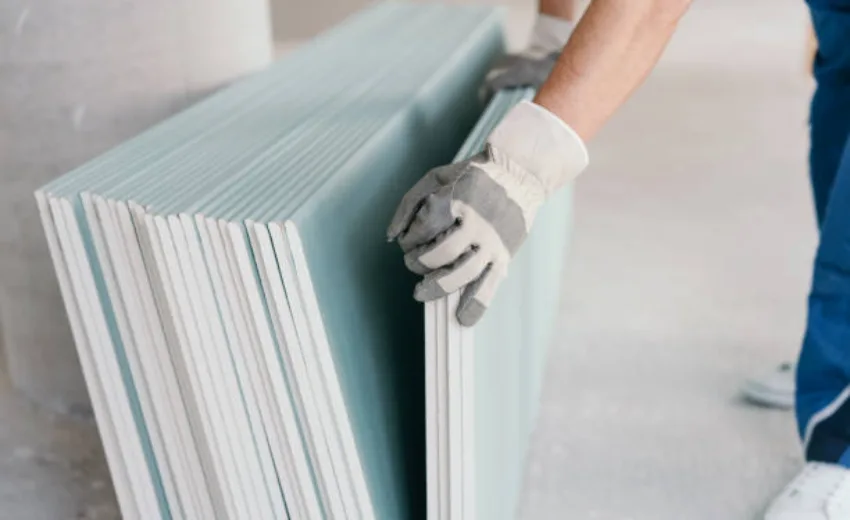Welcome to the world of drywall. Here, sheets of gypsum board form walls and ceilings in various buildings. But this isn’t just a dry lesson on materials. We’ll explore drywall’s complex journey, from its origins to today’s uses.
The days of messy plaster application are over. Now, builders just attach drywall sheets to a frame. Then, they finish with joint compound, tape, and texture. So, what exactly is drywall? How is it made? What types exist, and what are their uses?
This guide is for you. It’s for homeowners curious about their walls. And for contractors wanting to learn more. Let’s dive in and explore everything you need to know about drywall!
What is drywall?
Drywall, also called plasterboard, wallboard, and gypsum board, is a construction material. It is used to create interior walls and ceilings. It is made from a gypsum core sandwiched between two sheets of paper or fiberglass. The boards come in various thicknesses and sizes. You can easily cut, shape, and install them using screws or nails onto a framing structure.
Its low cost, fire resistance, and soundproofing make it popular in buildings. Its easy to install, too. It can also be finished with joint compound and textured. This creates a smooth or decorative surface.
Dimensions of Drywall
When building or renovating a space, choosing the right drywall size is key. Drywall is a popular choice for interior walls and ceilings. It’s cheap and easy to install. However, the wrong size or thickness can lead to a poor finish. This wastes time and materials, and increases costs. This article will explore drywall dimensions in-depth. It will cover thickness, length, and width.
- Drywall Thickness:
Drywall thickness can vary depending on the intended use of the space. For residential use, the most common thickness is 1/2 inch. For commercial buildings, or areas with high fire ratings, 5/8 inch is typical. Thinner drywall, such as 1/4 inch, is also available for curved surfaces or as a backing for other materials.
- Drywall size in length and width
Drywall sheets come in standard sizes, with the most common being 4 feet wide by 8 feet long. However, longer sheets (up to 16 feet) and wider sheets (up to 54 inches) are available. They reduce joints in larger areas. Additionally, smaller sheets are available for patching or smaller projects.
Note that drywall dimensions may vary slightly between manufacturers. So, double-check measurements before cutting or installing. Knowing drywall’s dimensions helps you install it better. It will look more professional.
What types of drywall are available?
There are several types of drywall available, each designed for specific applications. Knowing the types of drywall can help you choose the best one for your project. Here are the most common types of drywall:
- Standard Drywall: This is the most common type. It is used for interior walls and ceilings in residential and commercial buildings. It has a gypsum core sandwiched between two sheets of paper or fiberglass.
- Moisture-Resistant Drywall: Use this drywall in areas with high moisture, like bathrooms, kitchens, and laundry rooms. It has a water-resistant core and is covered with a green moisture-resistant paper.
- Fire-Resistant Drywall: It can withstand fire for a time. It has fire-resistant additives in the gypsum core. It is covered with pink, fire-resistant paper.
- Soundproof Drywall: It has extra layers of gypsum and other materials. They reduce sound transmission between rooms. It is commonly used in home theaters and recording studios. It’s for any place where sound quality is important.
- Abuse-Resistant Drywall: This type of drywall is designed to withstand impact and abuse, making it ideal for high-traffic areas such as schools and hospitals. It has a fiberglass-reinforced gypsum core. It is covered with a heavy-duty paper or fiberglass mat.
- Lightweight Drywall: This type of drywall is lighter and easier to handle than standard drywall, making it ideal for DIY projects or installations where weight is a concern. It has a foaming agent added to the gypsum core to reduce its weight.
What types of materials are used for building drywall?
Drywall, or gypsum board, is a construction material. It has a core of gypsum, a soft mineral, between two sheets of paper or fiberglass. However, the materials used to create drywall go beyond just gypsum and paper. Here are the types of materials commonly used in the construction of drywall:
1. Gypsum
As mentioned, gypsum is the core material of gypsum drywall. It is a soft mineral. It is mined or made from industrial byproducts, like flue gas desulfurization.
2. Paper or Fiberglass
The gypsum core of drywall is covered with paper or fiberglass. This adds strength, protection, and durability. Paper is the most common option. But, fiberglass is used for moisture-resistant and abuse-resistant drywall.
3. Additives
Additives can be added to the gypsum core to improve the drywall. For example, fire-resistant drywall has additives that boost its fire resistance. Moisture-resistant drywall has additives that boost its moisture resistance.
4. Adhesives
Adhesives are used to bind the gypsum core and the paper or fiberglass layers together. Starch, a natural adhesive, is commonly used, but synthetic adhesives may also be used.
5. Backing Materials
Drywall can be reinforced with additional materials for increased strength and durability. For example, adding fiberglass mat or paper to the back of the drywall can make it more resistant to damage.
Knowing the materials used to make drywall helps you choose the best type for your needs. Standard, moisture-resistant, and fire-resistant drywall each use unique materials and additives. They give each type of drywall its own properties and benefits.
Where is drywall used?
Drywall is used in construction to create interior walls and ceilings in buildings. These can be either residential or commercial. It is a popular choice for its affordability, ease of installation, and versatility. Here are some of the common places where drywall is used:
- Residential Homes: Drywall plays a crucial role in the construction of interior walls and ceilings in residential homes. It is a cheap, easy-to-install material. You can finish it with paint, wallpaper, or texture.
- Commercial Buildings: Drywall is used in commercial buildings, like offices, retail spaces, and hotels. It gives a smooth, even surface for interior walls and ceilings. It can be easily customized with different finishes and textures.
- Remodeling and Renovations: Drywall is often used in these projects. It replaces old or damaged walls and ceilings. You can install it over existing surfaces or use it to create new walls and partitions.
- Soundproofing and Fireproofing: There are special types of drywall for soundproofing and fireproofing. Use these types of drywall in home theaters and recording studios. They need good sound and fire resistance.
What are the advantages and disadvantages of drywall?
Drywall is a popular construction material. It has many benefits, but some drawbacks. Here are some of the main advantages and disadvantages of using drywall:
Advantages of Drywall:
- Affordability: Drywall is cheap. It is a popular choice for all kinds of construction projects.
- Ease of Installation: You can easily and quickly install drywall. This reduces labour costs and project timelines.
- Versatility: Drywall can be cut, shaped, and textured. This allows for many finishes. It is a versatile material that can be customized for various designs.
- Fire Resistance: Drywall is non-combustible. It can be treated with fire-resistant chemicals for extra fire protection.
- Soundproofing: Use special drywall to improve sound insulation and reduce noise between rooms.
Disadvantages of Drywall:
- Vulnerability to Moisture: Standard drywall is vulnerable to moisture. It can warp, sag, or grow mold. Moisture-resistant drywall can fix this. But, it costs more than standard drywall.
- Damage: Drywall can dent, scratch, and hole easily. It may need repairs or replacements.
- Environmental Impact: The drywall manufacturing process requires a lot of energy and creates waste. This can harm the environment.
- Health Concerns: The dust from installing and sanding drywall can irritate the lungs. The material may contain small amounts of harmful chemicals.
- Limited Structural Support: Drywall is not load-bearing. It cannot provide much support. Additional framing or support structures may be needed for heavy fixtures or equipment.
However, be aware of its limits and drawbacks. Choose the right type of drywall for your project and design needs.
FAQ About Drywall
- What is the difference between a wall and drywall?The main difference between wall and drywall is the construction process. Drywall is gypsum plaster pressed between two sheets of paper. Plaster walls are made by nailing strips of wood over wall studs. Then, they are covered with a mixture of water and powdered gypsum, cement, or lime. Drywall is a pre-made, lightweight, and easy-to-install material. Plaster walls take more work to install.
- Can you paint drywall?Yes, drywall can be painted, but it must be primed first to ensure the paint adheres properly. Before priming, the drywall should be sanded, vacuumed, and cleaned to remove all dust.
- Does drywall need plastering?Yes, drywall must be finished with joint compound, or mud. This creates a smooth, continuous surface. Drywall comes in large sheets. It can be easily installed by nailing or screwing it to the studs. However, you must apply joint compound to the seams and other flaws to create a seamless finish.
- Can I mount a TV on drywall?Yes, you can mount a TV on drywall. But the drywall must be strong enough to support the TV and the mounting bracket. We recommend using a wall stud to secure the bracket to the drywall. It provides the support needed for the TV. Alternatively, you can use drywall anchors for heavy loads. But it is important to follow the manufacturer’s instructions and weight limits.
- Is drywall good for walls?Yes, drywall is a popular material for walls in buildings. It is widely used in both residential and commercial construction. It’s easy to install, cheap, and gives a smooth, even surface for painting or wallpapering. Drywall is fire-resistant. Special coatings can make it more resistant to moisture and mold. However, it is vital to install and finish drywall properly. This avoids issues like cracking, bulging, or other structural problems.
Conclusion
Drywall is a common building material used for interior walls and ceilings. Builders make it from gypsum plaster sandwiched between two sheets of paper, and they find it easy to install and repair. Knowing what drywall is and its properties can help you. It will help you make better decisions in construction or renovation projects. Drywall is a great choice for any project. It’s versatile and durable, making it ideal for both DIYers and pros.
If you found this guide helpful, please share it. Others may benefit from learning about drywall. If you have questions or want to share your drywall experiences, please comment or contact us. Thank you for reading. We hope this guide has helped with your construction or renovation projects.




